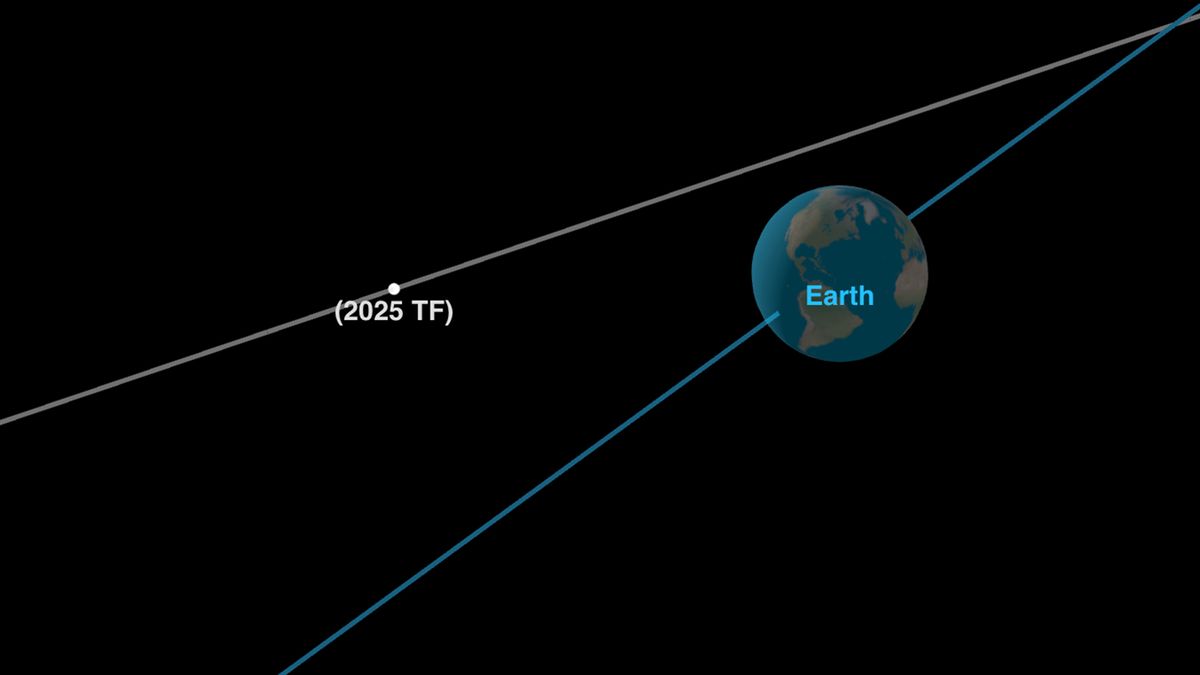☄️ An unexpected near-Earth asteroid just skimmed past Earth at 400 km
Follow us on Google News (click on ☆)
The flyby of this object occurred on October 1, 2025, precisely at 00:49 GMT, according to data collected by space observatories. With a modest size between 1.2 and 2.7 meters in diameter - comparable to that of a sofa - this asteroid moved about 400 kilometers (about 250 miles) above the Earth's surface. While this distance may seem significant on a human scale, it actually represents an extremely close pass in the spatial context, where distances are usually measured in millions of kilometers.

Representation of asteroid 2025 TF during its closest approach to Earth on October 1, 2025, at an altitude of about 300 kilometers (about 190 miles). The object measured about 2 meters in diameter.
Credit: NASA/JPL-Caltech
This close pass, however, is not the closest ever recorded. Five years ago, asteroid 2020 VT4 set a record by skimming our planet at an altitude of only 370 kilometers (about 230 miles). What makes these observations particular is that these small celestial bodies are often detected after their closest approach, as was the case for 2025 TF, which was only spotted by astronomers a few hours after its maximum approach. This detection difficulty is explained by their small size and high speed.
The space surveillance network, mainly consisting of ground-based and space telescopes, is optimized to detect larger and potentially hazardous objects. The Catalina Sky Survey, a research program based in Arizona, was the first to identify 2025 TF shortly after its pass over Antarctica. The data shared by the Minor Planet Center, the international organization that coordinates asteroid observations, allowed the scientific community to reconstruct the precise trajectory of this celestial object.
The monitoring of near-Earth objects represents an essential scientific activity for planetary protection. NASA, in collaboration with other international space agencies, maintains a continuous program for detecting and tracking asteroids that could pose a risk to Earth. Recent technological advances now allow for the identification of several such close passes each week, demonstrating the constant improvement in astronomical observation capabilities.
Monitoring Near-Earth Objects
The detection of asteroids near Earth represents a major scientific challenge for planetary security. Astronomers use a global network of specialized telescopes that continuously scan the sky in search of these celestial visitors.
These instruments are calibrated to identify objects larger than a few meters, as these are the ones that could cause significant damage upon impact. Smaller asteroids, like 2025 TF, often remain invisible until their closest approach, or even after their passage.
Monitoring programs like the Catalina Sky Survey work by automatically analyzing thousands of sky images each night. Algorithms compare these snapshots to detect bright points that move relative to the fixed stars, a characteristic signature of asteroids.
The collected data is then transmitted to the Minor Planet Center, which coordinates observations internationally and calculates the precise orbits of these objects.
Characteristics of Small Asteroids
Small asteroids, like 2025 TF, exhibit particular physical properties that distinguish them from their more massive counterparts. Their composition can vary considerably, ranging from metallic rocks to loosely bound aggregates of dust and ice.
These objects move at impressive speeds, generally between 10 and 30 kilometers per second (about 22,000 to 67,000 mph). At such speeds, even an asteroid a few meters across carries kinetic energy equivalent to several tons of TNT, although most disintegrate in the Earth's atmosphere.
Detecting these small bodies is made difficult by their low brightness. A two-meter diameter asteroid reflects so little sunlight that it becomes invisible to telescopes until it comes very close to Earth.
The study of these objects allows scientists to better understand the asteroid population in the inner solar system and to refine models of impact frequency on our planet.